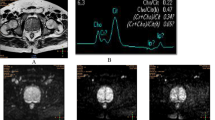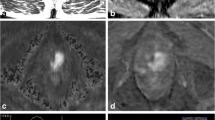Abstract
Purpose
The purpose of this study was to evaluate the role of magnetic resonance spectroscopic imaging (MRSI) and dynamic contrast-enhanced magnetic resonance imaging (DCE-MRI) in detecting tumour foci in patients with elevated prostate-specific antigen (PSA) and negative transrectal ultrasonography (TRUS)-guided biopsy.
Materials and methods
This prospective randomised trial was conducted on 150 patients who underwent [1H]MRSI and DCE-MRI and targeted biopsies of suspicious areas on MRI associated with random biopsies.
Results
After the second biopsy, the diagnosis of prostate adenocarcinoma was made in 64/150 cases. On a perpatient basis, MRSI had 82.8% sensitivity, 91.8% specificity, 88.3% positive predictive value (PPV), 87.8% negative predictive value (NPV) and 85.7% diagnostic accuracy. The sensitivity, specificity, PPV, NPV and accuracy for DCE-MRI was 76.5%, 89.5%, 84.5%, 83.7% and 82%, respectively. The combination of MRSI and DCE-MRI yielded 93.7% sensitivity, 90.7% specificity, 88.2% PPV, 95.1% NPV and 90.9% accuracy in detecting prostate carcinoma.
Conclusions
The combined study with [1H]MRSI and DCE-MRI showed promising results in guiding the biopsy of cancer foci in patients with an initial negative TRUS-guided biopsy.
Riassunto
Obiettivo
Scopo del nostro lavoro è stato valutare il ruolo della risonanza magnetica (RM) con spettroscopia (MRSI) e studio dinamico (DCEMR) nell’individuazione di foci tumorali in pazienti con elevati valori di antigene prostatico specifico (PSA) e biopsia prostatica guidata tramite TRUS (trans-rectal-ultrasound)-guidata negativa.
Materiali e metodi
Lo studio è stato di tipo prospettico randomizzato. Abbiamo esaminato 150 pazienti. Tutti sono stati sottoposti ad esame di 1H-MRSI e DCEMR ed a prelievi mirati nelle zone sospette alla RM, associate a biopsie random.
Risultati
Dopo la seconda biopsia, la diagnosi di adenocarcinoma prostatico è stata effettuata in 64/150 casi. Nella nostra popolazione, su una base patient by patient, l’MRSI ha mostrato i seguenti valori: sensibilità 82,8%; specificità 91,8%; valore predittivo positivo (PPV) 88,3%; valore predittivo negativo (NPV) 87,8%; accuratezza 85,7%. La DCEMR ha mostrato i seguenti valori: sensibilità 76,5%; specificità 89,5%; PPV 84,5%; NPV 83,7%; accuratezza 82%. L’associazione delle due metodiche, MRSI e DCEMR, aumenta la sensibilità (93,7%), la specificità (90,7%), il PPV (88,2%), il PNV (95,1%) e l’accuratezza (90,9%) nel predire l’individuazione del carcinoma prostatico se paragonata alla sola metodica MRSI o DCEMR.
Conclusioni
Lo studio combinato ha mostrato risultati promettenti nella guida alla biopsia dei foci tumorali in pazienti con prima biopsia TRUS-guidata negativa.
Similar content being viewed by others
References/Bibliografia
Heidenreich A, Aus G, Bolla M et al (2008) EAU guidelines on prostate cancer. Eur Urol 53:68–80
Catalona WJ (1996) Clinical utility of measurement of free and total prostate specific antigen (PSA): a review. Prostate 7[suppl]: 64
Seitz M, Shukla-Dave A, Bjartell A et al (2009) Functional magnetic resonance imaging in prostate cancer. Eur Urol 55:801–814
Panebianco V, Sciarra A, Osimani M et al (2009) 2D and 3D T2-weighted MR sequence for the assessment of neurovascular bundles changes after nerve sparing radical prostatectomy with erectile function correlation. Eur Radiol 19:220–229
Kirkham AP, Emberton M, Allen C (2006) How good is MRI at detecting and characterising cancer within the prostate? Eur Urol 50:1163–1175
Carlani M, Mancino S, Bonanno E et al (2008) Combined morphological, [1H] spectrocopic and contrast enhanced imaging of human prostate cancer with a 3-Tesla scanner: preliminary experience. Radiol Med 113:670–688
Rajesh A, Coakley FV, Khrhanewicz J (2007) 3D spectroscopic imaging in the evaluation of prostate cancer. Clin Radiol 62:921–929
Hricak H (2005) MR imaging and MR spectroscopic imaging in the pretreatment evaluation of prostate cancer. Br J Radiol 78:103–111
Rajesh A, Coakley FV (2004) MR imaging and MR spectroscopic imaging of prostate cancer. Magn Reson Imaging Clin N Am 12:557–579
Manenti G, Squillaci E, Carlani M et al (2006) Magnetic resonance imaging of the prostate with spectroscopic imaging using a surface coil. Initial clinical experience. Radiol Med 111:22–32
Casciani E, Gualdi G (2006) Prostate cancer: value of magnetic resonance spectroscopy 3D chemical shift imaging Abdom Imaging 31:490–499
Sciarra A, Salciccia S, Panebianco V (2008) Proton spectroscopic and dynamic contrast-enhanced magnetic resonance: a modern approach in prostate cancer imaging. Eur Urol 54:485–488
Yuen JSP, Thng CH, Tan PH et al (2004) Endorectal magnetic resonance imaging and spectroscopy for the detection of tumor foci in men with prior negative transrectal ultrasound prostate biopsy. J Urol 171:1482–1486
Amsellem-Ouazana D, Younes P, Conquy S et al (2005) Negative prostatic biopsies in patients with high risk of prostate cancer. Is the combination of endorectal MRI and magnetic resonance spectroscopy imaging (MRSI) a useful tool? A preliminary study. Eur Urol 47:582–586
Zackrisson B, Aus G, Bergdahl S et al (2004) The risk of findings focal cancer (less than 3 mm) remains high on rebiopsy of patients with persistently increased prostate specific antigen but the clinical significance is questionable. J Urol 171:1500–1503
Sciarra A, Autran Gomez A, Salciccia S et al (2008) Biopsy-derived Gleason artifact and prostate volume: experience using ten samples in larger prostates. Urol Int 80:145–150
Kumar R, Nayyar R, Kumar V (2008) Potential of magnetic resonance spectroscopic imaging in predicting absence of prostate cancer in men with serum prostate-specific antigen between 4 and 10 ng/ml: a follow-up study. Urology 72:859–863
Wefer AE, Hricak H, Vigneron DB et al (2000) Sextant localization of prostate cancer: comparison of sextant biopsy, magnetic resonance imaging and magnetic resonance spectroscopic imaging with step section histology. J Urol 164:400–404
Testa C, Schiavina R, Lodi R et al (2007) Prostate cancer: sextant localization with MR imaging, MR spectroscopy, and 11-choline PET/CT. Radiology 244:797–806
Kurhanewicz J, Vigneron DB, Hricak H et al (1996) Three-dimensional H-1 MR spectroscopic imaging of the in situ human prostate with high (0.24–0.7-cm3) spatial resolution. Radiology 198:795–805
Cirillo S, Petracchini M, Della Monica P et al (2008) Value of endorectal MRI and MRS in patients with elevated prostate-specific antigen levels and previous negative biopsies to localize peripheral zone tumors. Clin Radiol 63:871–879
Fütterer JJ, Heijmink SW, Scheenen TW et al (2006) Prostate cancer localization with dynamic contrast-enhanced MR imaging and proton MR spectroscopic imaging. Radiology 241:449–458
Wetter A, Hübner F, Lehnert T et al (2005) Three-dimensional 1H-magnetic resonance spectroscopy of the prostate in clinical practice: technique and results in patients with elevated prostatespecific antigen and negative or no previous prostate biopsies. Eur Radiol 15:645–652
Lawrentschuk N, Fleshner N (2009) The role of magnetic resonance imaging in targeting prostate cancer in patients with previous negative biopsies and elevated prostate-specific antigen levels. BJU Int 103:730–733
Scattoni V, Zlotta A, Montironi R et al (2007) Extended and saturation prostatic biopsy in the diagnosis and characterisation of prostate cancer: a critical analysis of the literature. Eur Urol 52:1309–1322
Rabets JC, Jones JS, Patel A Zippe CD (2004) Prostate cancer detection with office based saturation biopsy in a repeat biopsy population. J Urol 172:94–97
Perrotti M, Han KR, Epstein RE et al (1999) Prospective evaluation of endorectal magnetic resonance imaging to detect tumor foci in men with prior negative prostatic biopsy: a pilot study. J Urol 162:1314–1322
Vilanova JC, Comet J, Capdevila A et al (2001) The value of endorectal MR imaging to predict positive biopsies in clinically intermadiate-risk prostate cancer patients. Eur Radiol 11:229–235
Author information
Authors and Affiliations
Corresponding author
Rights and permissions
About this article
Cite this article
Panebianco, V., Sciarra, A., Ciccariello, M. et al. Role of magnetic resonance spectroscopic imaging ([1H]MRSI) and dynamic contrast-enhanced MRI (DCE-MRI) in identifying prostate cancer foci in patients with negative biopsy and high levels of prostate-specific antigen (PSA). Radiol med 115, 1314–1329 (2010). https://doi.org/10.1007/s11547-010-0575-3
Received:
Accepted:
Published:
Issue Date:
DOI: https://doi.org/10.1007/s11547-010-0575-3




